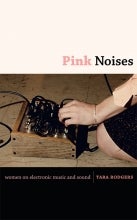Review | Pink Noises: Women on Electronic Music and Sound by Tara Rodgers

Pink Noises: Women on Electronic Music and Sound. By Tara Rodgers. Durham and London: Duke University Press, 2010. [xi, 336 p. ISBN 9780822346739. $24.95] 38 Illustrations, glossary, discography, references, index.
Reviewed by Tiffany Naiman
Tara Rodgers, a composer and scholar, rightly perceives a lack of academic and mainstream media attention towards women creating electronic music, and in 2000 she created the website pinknoises.com as a collective space for female artists to promote their work, get tips and information regarding production methods, and discuss the trials and tribulations of working in a field where men often dominate the discussion.
The book Pink Noises: Women on Electronic Music and Sound is an expansion of Tara Rodgers’ website and contains far more extensive interviews with twenty-four female electronic musicians, composers, sound artists, and DJs whom Rodgers has come in contact with during her research and career. Rodgers’ own critical introduction announces that the book is “concerned with how histories are contained and contested in movements of sound in the present” (5) and discusses the relationships between gender, technology, and electronic music cultures, nicely setting out a road map for further discourse concerning the ways in which gender operates within the broader community, mainstream media, concert promoting, and a variety of other public arenas.
While one cannot help but applaud her aims, Rodgers’ interview questions at times tend to feel journalistic and the results anecdotal, rather than providing a product that pushes towards theoretical inquiry. In some instances this could be seen as a plus, as it allows the book to be easily accessible. I suggest that her casual approach is an important part of the project as Rodgers “was inspired by the legacy of Riot Grrrl,” (3) which worked to be an inclusive space for women to create, learn, and organize within the male-dominated American punk scene in the 1990s. By not filling the book with pages of technical jargon and by including a glossary, Rodgers creates an inviting book for readers who are interested in the subject, but are not highly versed in the mechanics of electronic sound creation. By presenting the various interviews with seminal female electronic music artists in one place, Pink Noises provides easy access to influential, creative female voices, which allows them to be heard and to possibly inspire others as was the hope with the Riot Grrrl movement. Though these interviews aid in the understanding of the artists’ personal histories, production practices, and the ways in which they feel their gender may or may not inform their work, they offer little substantial critical attentiveness to systems of control, power, or desire that contribute to female practitioners being discussed in the periphery.
Part of what makes Pink Noises compelling is that the interviewees span various cultural backgrounds and generations, yet the questions posed to them do not lead the artists to any discussion about the intersections of being women along with their ethnicity, class, age, or sexual orientation. Thus, we are given a book that skims the surface of who these artists really are other than being women working in a field that has for the most part been dominated by men. This is not to say that the stories are not interesting or valuable; we hear from the founders of the Liquid Sound Lounge radio show and the legendary Basement Bhangra parties in New York, creators of sound sculptures and sonic software, as well as the woman who created the philosophy of Deep Listening.
The interviews are divided thematically into six parts: Time and Memory; Space and Perspective; Nature and Synthetics; Circulation and Movements; Language, Machines, Embodiment; Alone/Together. These six parts give the reader a base from which to consider and engage with the work of the artists found in each section. Each and every interview contains elements of inspiration along with direction towards information for those looking for a way into developing their own art or music that engages with technology. The interviews all discuss technology in terms of discovery and expanse, which are in direct opposition to the “macho control” (10) that Rodgers points to in her introduction. The breadth of these interviews impressively demonstrates how extraordinarily diverse the genre of electronic sound creation truly is.
Because of the instruction and interviews contained in Pink Noises, the book is a valuable resource for women who hope to create electronic music and sound, and for them to know their foremothers, even if it falls short in providing analysis that would be the focus for an academic reader. Rodgers book takes a first step in bringing these female musicians/artists/composers into a cohesive project, starting a discussion for others to pick up and add to. Pink Noises does well to highlight the fact that women have been and continue to be key producers and innovators in the field of electronic music and sound. This book functions as a corrective, working toward remedying the long silence that has enveloped the topic of women in electronic music.





